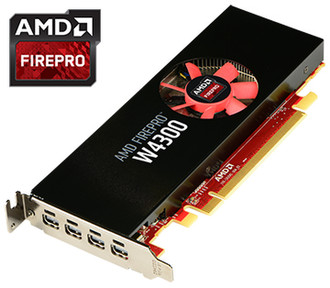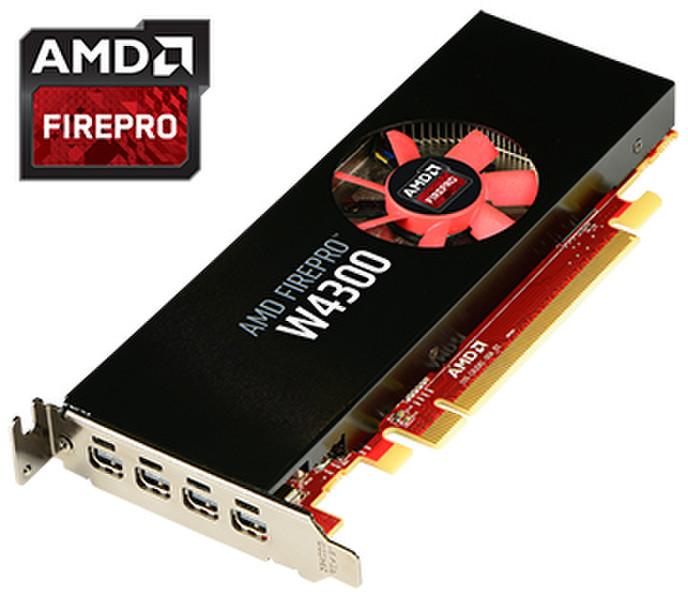目錄的
-
目錄的
- Antiquitäten & Kunst
- Auto & Motorrad: Fahrzeuge
- Baby
- Bücher
- Camping & Outdoor
- Feinschmecker
- Haustierbedarf
- Heimwerken & Garten
- IT和电子
- Kleidung & Accessoires
- Modellbau
- Musik
- PC- & Videospiele
- Sammeln & Seltenes
- Spielzeug
- TV, Video, DVD
- Telekommunikation
- Uhren & Schmuck
- Wellness & Beauty
- fashion & lifestyle
- institutional food services equipment
- medical equipment, accessories & supplies
- 个人护理
- 休闲爱好
- 办公设备,用品和配件
- 商业与工业
- 家居,建筑,装修
- 家用电器
- 摩托车及配件
- 武器和弹药
- 照相机
- 花园和庭院
- 运动,娱乐及休闲
- 食物
- 高保真音響
Filters
Search
AMD 31004-56-40A FirePro W4300 4GB GDDR5 graphics card
凡购买和价格 (Advertising *)
顶部
技术特点
顶部
内存参数
| 图形适配器内存类型 | GDDR5 |
|---|---|
| 内存带宽(最大) | 98 GB/s |
| 数据宽度 | 128 bit |
| 独立显卡适配器內存 | 4 GB |
性能
| DirectX版本 | 12.0 |
|---|---|
| OpenGL版本 | 4.4 |
| 最高着色模型版本 | 5.0 |
| PhysX | N |
| OpenCL版本 | 2.0 |
| 集成电视调谐器 | N |
| Full HD | Y |
处理器
| 图形处理器系列 | AMD |
|---|---|
| 最大模拟分辨率 | 2560 x 1600 pixels |
| 最大数字分辨率 | 4096 x 2160 pixels |
| 流处理器 | 768 |
端口 & 界面
| 接口类型 | PCI Express x16 3.0 |
|---|---|
| DisplayPort 数量 | 3 |
设计
| 插槽数量 | 1 |
|---|---|
| 风扇数量 | 1 fan(s) |
| 冷却方式 | Active |
另外
| 图形处理器 | FirePro W4300 |
|---|---|
| 双dvi(互应式数字视频) | N |
FirePro W4300, 4GB GDDR5, 128-bit
Application Certifications
The AMD FirePro™ professional graphics product family is certified on more than 100 different applications for improved performance and reliability, including the most popular design and engineering and media and entertainment applications.
4GB GDDR5 Memory
Helps to improve overall workstation speed and responsiveness, and application performance. Load large assemblies, models and data sets, or advanced visual effects, and manipulate them with ease.
DirectGMA (Direct Graphics Memory Access) Support
DirectGMA bypasses any need to traverse the host’s main memory, reducing CPU utilization, and avoids redundant transfers over the PCIe® interface, resulting in high throughput, low latency data transfers.
GeometryBoost
Allows the GPU to process geometry data at a rate of twice per clock cycle resulting in a doubling in the rate of primitive and vertex processing. Triangle rates increase two-fold relative to a GPU that does not possess GeometryBoost.
AMD Eyefinity Technology
A multidisplay technology enabling highly immersive and powerful multitasking experience across up to four displays, powered by a single AMD FirePro™ W4300 graphics card2.
OpenCL™ 2.0 Support
Tap into the parallel computing power of modern GPUs and multicore CPUs to accelerate compute-intensive tasks in leading CAD/CAM/CAE and media and entertainment applications that support OpenCL. AMD FirePro™ W4300 supports OpenCL 1.2 and is expected to support OpenCL 2.0, allowing developers to take advantage of new features that give GPUs more freedom to do the work they are designed to do.
1.43 TFLOPS of peak single-precision floating-point performance
Helps speed up time required to complete single precision operations used within Video Enhancement, Signal Processing, Video Transcoding and Digital Rendering applications.
The AMD FirePro™ professional graphics product family is certified on more than 100 different applications for improved performance and reliability, including the most popular design and engineering and media and entertainment applications.
4GB GDDR5 Memory
Helps to improve overall workstation speed and responsiveness, and application performance. Load large assemblies, models and data sets, or advanced visual effects, and manipulate them with ease.
DirectGMA (Direct Graphics Memory Access) Support
DirectGMA bypasses any need to traverse the host’s main memory, reducing CPU utilization, and avoids redundant transfers over the PCIe® interface, resulting in high throughput, low latency data transfers.
GeometryBoost
Allows the GPU to process geometry data at a rate of twice per clock cycle resulting in a doubling in the rate of primitive and vertex processing. Triangle rates increase two-fold relative to a GPU that does not possess GeometryBoost.
AMD Eyefinity Technology
A multidisplay technology enabling highly immersive and powerful multitasking experience across up to four displays, powered by a single AMD FirePro™ W4300 graphics card2.
OpenCL™ 2.0 Support
Tap into the parallel computing power of modern GPUs and multicore CPUs to accelerate compute-intensive tasks in leading CAD/CAM/CAE and media and entertainment applications that support OpenCL. AMD FirePro™ W4300 supports OpenCL 1.2 and is expected to support OpenCL 2.0, allowing developers to take advantage of new features that give GPUs more freedom to do the work they are designed to do.
1.43 TFLOPS of peak single-precision floating-point performance
Helps speed up time required to complete single precision operations used within Video Enhancement, Signal Processing, Video Transcoding and Digital Rendering applications.
-
支付方式
我们接受:











